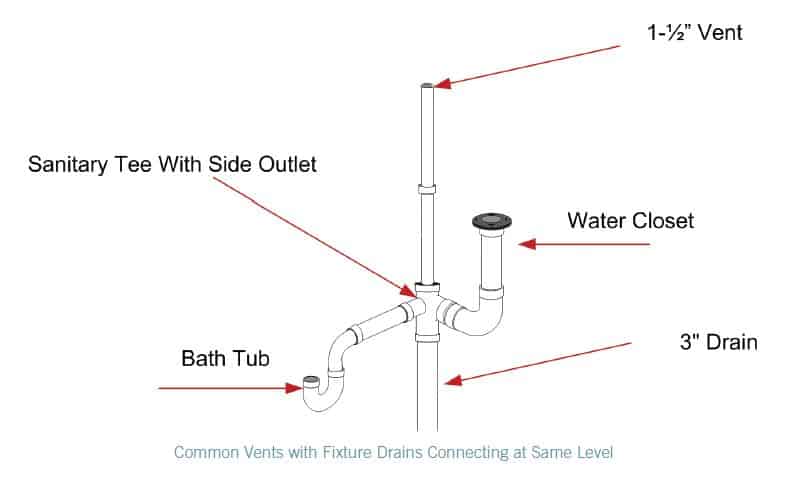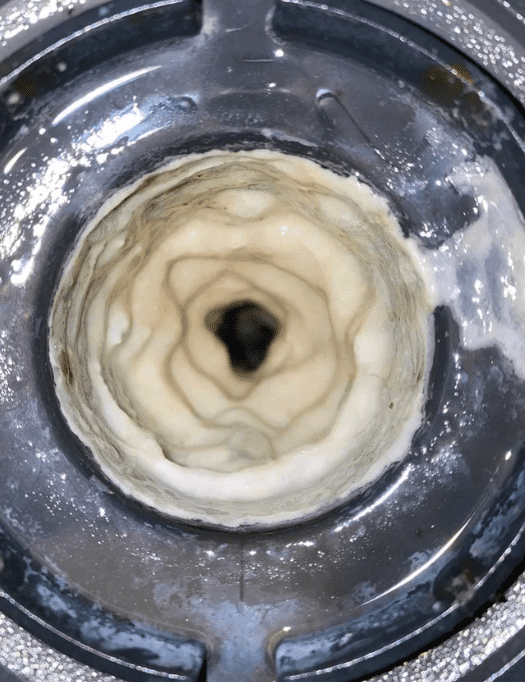So let me guess:
When you run the shower, your toilet makes a mysterious bubbling or gurgling noise.
You aren’t sure if this air bubble issue is severe enough to warrant spending $70 to $120 per hour (the average cost of a plumber before trip fees and materials)
This issue is usually caused by a blocked drain line or a vent pipe. In some cases, it can indicate a damaged sewer main line—leading to toxic gases back-up or water overflowing from the toilet.
But how do I differentiate? And more importantly, how do I fix it without calling a plumber? What if my home has a septic tank, not a city sewer line?
Not an issue! I’ll share everything I’ve learned from several licensed plumbers while running a full-service construction company in Phoenix, AZ.
Let’s dive right into it!
- Understanding Wet Vented Plumbing Systems
- How to Diagnose the Problem and Narrow Down to the Solution
- 1. Unclog the Shower/Tub and Toilet Drain
- 1.1 What Causes a Clog in My Shower Drain?
- 1.2 Easy Fixes: Remove Visible Obstructions Using a Coat Hanger, Hot Water, or a Mixture of Baking Soda With Vinegar
- 1.3 Plunge the Shower/Bath-tub and the Toilet Drain
- 1.4 Plunging Doesn't Work? Try Unclogging With a Drain Snake Auger (Plumbing Snake)
- 1.5 Nothing Works? Try Using an Electric Power Auger
- 2. Unclog the Blocked Vent Pipe/Stack
- 3. What to Do if Everything Fails
- Frequently Asked Questions (FAQs)
Understanding Wet Vented Plumbing Systems

A wet vent is a pipe that doubles as a waste pipe and a vent simultaneously. These days most bathrooms are wet-vented, saving a lot of time and money due to the less piping required. For example, Kurt says he uses his lavatory as a wet vent for the shower/tub about 90% of the time. “It’s only when the conditions seem unrealistic that I dry went a shower,” he adds.
The toilet bubbling phenomenan can happen if your bathroom is wet-vented. If the drains are close (like your shower and toilet drain), they are usually vented through the same drain mainline and the vent pipe. If there’s a clog in the drain pipe or the vent pipe, using a plumbing fixture (such as the shower) leads to air being forced into or out of another fixture (such as the toilet.) This clog and air force cause air bubbling in your toilet when you turn on your shower.
How to Diagnose the Problem and Narrow Down to the Solution
The most important question is to ask:
Does the bubbling/gurgling affect only a particular toilet or multiple plumbing fixtures?
If the blockage affects a particular toilet or shower, this indicates that a specific drain is clogged.
If your home has a city sewer system:
If all the toilets or multiple plumbing fixtures in your home gurgle, this could indicate a main sewer line block. You might also experience water draining slowly or water back-ups in the shower or bathtub. Since toilets have the largest drain pipe out of all fixtures and have the most direct route to the main drain, problems typically appear there first.
If your home has a septic tank system:
You could experience back ups if your septic tank is full. The United States Environment Protection Agency (EPA) recommends emptying the tank every two to three years by mechanical pumping.
No matter what your situation is:
We’ll guide you step-by-step to get help rid of your toilet bubbling. You can use the above tips to narrow down the issue and skip to the relevant fixes below.
Before you begin, ensure that the municipal sewer line is not clogged by confirming this issue with your neighbors. If multiple families report this issue, it might be worth calling your city’s municipal sewer authority.

Kurt Joyce
1. Unclog the Shower/Tub and Toilet Drain
1.1 What Causes a Clog in My Shower Drain?

The most common causes of a shower drain clog are human hairs, soap scum, and hard water. Hairs can not only restrict water flow but also stick to grime and soap scum to worsen the problem. The soap can get mixed with the hard water to form a soap scum that sticks to the inner sides of the drain. If your area has hard water, calcium and iron can stick to the sides of the drain.
1.2 Easy Fixes: Remove Visible Obstructions Using a Coat Hanger, Hot Water, or a Mixture of Baking Soda With Vinegar
Remove the drain cover. Pour hot water around the edges. This can help dissolve the build-up of soap scum. If you’ve PVC pipes, skip this step as the heat can damage PVC pipes. Remove the soap scum and hairs. You can use a flashlight if nothing is visible.
We hear you asking:
Can I use a wire coat hanger to clean the drain? Yes, you can use a coat hanger if the clog is near the surface of the drain. We’ve seen some plumbers’ advice against it since it can get stuck, worsening the clog. But in our experience, it’s alright to do so as long as you’re careful about it.
Alternatively, you can also try mixing 1⁄3 cup of baking soda with 1⁄3 cup of vinegar and flush it down the drain. Cover the drain and let it sit for 15 to 30 minutes. Pour boiling water down the drain. The bubbling reaction from this chemical reaction can sometimes help break up the grease or oil residues.
1.3 Plunge the Shower/Bath-tub and the Toilet Drain
A plunger is a simple plumbing tool that uses suction and pressure to remove a blockage in the drain.
Before plunging into the bathtub or shower drain:
Use a wet rag or duct tape to block the overflow opening on the front wall of the bathtub. To do this, you may need to remove the cover on the overflow tube. The overflow opening in shower drains generally sealed, so the drain is completely enclosed.
Here’s why:
If you don’t seal the drains, the air pressure can simply escape through other drains—making our plunging process less effective.
How to (correctly) use a plunger to plunge a shower, bathtub, or toilet drain:
- As mentioned above, ensure you’ve sealed the overflow using a wet rag or duct tape.
- Cover the drain opening completely with the plunger. The tighter the seal, the better. Try using a silicone lubricant if you don’t get a good seal.
- Fill enough water in the tub till the cup of the plunger is covered.
- Thrust the plunger up and down. Repeat this process a few times.
- If the water drains away, the unclog has been successful.
Next, attempt the same process over the toilet drain. An important thing to note is that while you can use a standard cup plunger for a shower drain, you will need a flange plunger or an accordion plunger for toilets. This is because a flange plunger has a cup and a soft rubber flap that helps create suction for the curved toilet drain. Flange plumbers can handle both sinks and toilets, but we do not recommend doing so due to the possibility of cross-contamination.
We don’t recommend using chemical cleaners because they can cause damage to the plumbing, mix with the water supply, and be a hazard for us and the environment. To top that, they aren’t even very effective in removing clogs.

Kurt Joyce
1.4 Plunging Doesn’t Work? Try Unclogging With a Drain Snake Auger (Plumbing Snake)
What is a Drain Snake?
A drain snake is a type of flexible auger that can help remove clogs when a plunger doesn’t work. The coiled-shaped metal wire can break up obstructions to enable water to flow again.
To unclog a sink drain, you’ll need a hand auger. In our experience, it’s not a good idea to run a hand auger through toilets for two reasons:
- Toilets often have a larger drain pipe than most plumbing fixtures—leading to a tangled snake. Most plumbers recommend using a 1/4″ wire for less than 2 inches of the drain pipe.
- The wire can damage your porcelain bowl.
To unclog a toilet drain, use a closet/toilet auger. The hook-shaped metal tubing makes it easier to insert the auger into the toilet.
How to Unclog With a Drain Snake or a Closet Auger
Most augers can reach up to 25 feet—so you can easily find one for your needs. Crank the auger until you experience some form of resistance. Gently push the auger back and forth a few times to break down the clog. Then, remove the auger and run the water for about 5 minutes to flush the clog away.
1.5 Nothing Works? Try Using an Electric Power Auger
Sometimes, the clog is so deep down that it’s not possible to reach with a manual auger. A motorized or power auger can reach 100+ feet. However, it might be overkill to buy one for casual purposes. Instead, it can be helpful to rent one from your local home improvement or a big box store.
A fair bit of warning, though: You should use an electric auger only if you’re comfortable with home DIY repairs. If you’re attempting to unclog the toilet, you might need to remove the toilet from the base since the auger’s head could be too big to fit into the toilet bowl. If you’re inexperienced or attempting this for the first time, just skip to the next section.
Most local home improvement stores will let you rent one depending on the diameter of the pipe you’re attempting to clean and how deep you want to clean—ranging from $40 to $50 per day.
2. Unclog the Blocked Vent Pipe/Stack
If unclogging the toilet or sink doesn’t work, the issue is likely a clogged vent pipe.
What is the vent stack? The vent pipe is a vertical pipe located on your home’s roof. Its advantages are two-fold:
- It regulates the airflow in your plumbing system. The drain pipes cannot move the waste and water without proper air circulation.
- It removes sewer gases. Sometimes, these foul and dangerous sewer gases can back up to your home. If you can smell strange gases, it can be a tale-tell sign of an issue with the vent pipe.
What causes it to block? Common things that block the vent pipe are leaves, debris, insects, and sometimes—dead mice and nests (yes, we’ve seen the last two!)
How to clear a blocked vent pipe?
- Clearing a blocked vent pipe will require you to get on the roof—so make sure you’re comfortable doing that.
- If you’ve multiple vent stacks, look for the one near the bathroom where the bubbling or gurgling happens. If you can see only one pipe, multiple vents have been combined into one.
- Remove any leaves or debris you may find at the surface.
- Use a thin flashlight to look further down. If you can see any obstructions, such as dead mice or insects, try removing them with a wire hanger.
- Pour down the water in the vent using a garden hose.
- Consider installing a screen over your vent pipe. Keeping foreign objects out of your vent pipe prevents costly plumbing repairs.
3. What to Do if Everything Fails
In our experience, unclogging the drain and the vent pipe should fix the gurgling toilet issue in a vast majority of cases. In the rare case it does not, here are some additional tips:
- Your main sewer line may be clogged. A tell-tale sign of this is multiple plumbing fixtures in your home are bubbling, you hear a strange gas smell, or if there’s water back-up. At this point, we recommend calling a professional sewer repair company. They can use hydro-jetting to shoot up to 4,000 PSI of water through the pipes—enough to break down tree roots or anything clogging the sewer line.
- Your plumbing might have inherent problems, such as an uphill drain.
- If your home is new, it’s possible that the vent has not been installed or is incorrectly installed. Weirdly, we’ve seen cases when the vent pipe is just horizontal. Ensure it is upright and vertical. If everything fails, it’s time to call a professional licensed plumber.
Frequently Asked Questions (FAQs)
Can a Gurgling Toilet Fix Itself?
In some cases, gurgling sounds can go away on their own if the clog in the drain or vent pipe clears. This usually happens when water builds up in the pipes, creating enough pressure to unblock the clog partially. However, if you can hear a gurgling noise with a strange gas smell, this could be a plumbing emergency. Read our guide to diagnose and fix this issue.
Can a Full Septic Tank Case Gurgling?
A full septic pump can cause gurgling noise in multiple plumbing fixtures such as shower drain, toilet, and sink. This happens because the tank cannot drain. The EPA recommends that you empty the tank every two to three years by mechanical pumping.
Why Does my Toilet Overflow When Shower is Running?
If your toilet overflows when your shower runs, it indicates a clog in your drain line. When you shower, the water backs up and overflows from the toilet. In most cases, you can fix this issue by unclogging with a plunger or a toilet snake/auger.
Why is My Shower Drain Bubbling?
The bubbling noise from your shower drain indicates a clog in the drain or vent pipe. If the air cannot escape through the pipes due to the clog, it creates a shower drain bubbling noise. In most cases, you can fix this issue by unblocking the drain pipe and the vent stack.
Homes With Septic Tanks: Why Does my Toilet Gurgle After Heavy Rain?
If your toilet only gurgles when it rains, you might have rainwater pouring into the septic tank— the excess water flow-restricting airflow, causing overflowing or gurgling noise. A cracked pipe or a sump pump in the basement can cause this problem.
Why Does my Toilet Gurgles and Smells?
If your toilet gurgling is accompanied by a strange rotten-eggs-like smell, this could indicate that the sewer gases are backing up into your home. This is usually caused by clogged drains, blocked air vents, or cracked pipes. These sewer gases contain toxic gases like hydrogen sulfide and ammonia—causing headaches and dizziness. We recommend you get this issue inspected by a licensed plumber.
